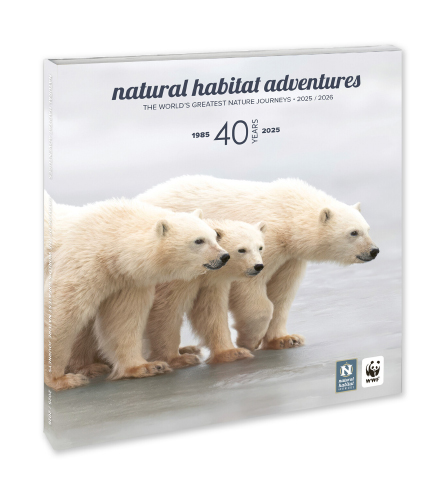
Found in cold waters along a quarter of the world’s coasts, kelp forests are the foundations of many marine ecosystems. They also absorb enormous amounts of pollution, help sequester planet-warming gases and underpin coastal fisheries and the seafood industry—benefits valued at $500 billion a year.
Found along 25% to 30% of the world’s coastlines, kelp forests are the most extensive marine vegetated ecosystems in the world. A type of seaweed, kelp attaches to rocky surfaces on the ocean floor and—like terrestrial plants and trees—grows upward toward the sunlight. Some experts even call kelp “the sequoias of the sea.” It’s an appropriate epithet: stems of bull kelp can soar more than 100 feet high, and their canopies—the frond-like blades that tangle on the ocean surface—are visible from space.
Kelp forests harbor a greater variety and higher diversity of animals and plants than almost any other ocean community. Many organisms use the thick blades to shelter their young from predators or even rough storms. Underwater towers of kelp provide food and habitat for all kinds of marine life, including birds, crustaceans and other invertebrates, fish, sea lions, sea otters, seals, whales and several commercially important fishery species, such as kelp bass and black rockfish.
Unfortunately, however, today kelp forests face a variety of threats, such as commercial kelp harvesting, pollution and climate change, which exacerbates El Nino Southern Oscillation events and negatively impacts kelp reproduction and survival. Overgrazing by fish and sea urchins is a particularly large problem for kelp forests. Predators such as sea otters and sea stars typically keep populations of urchins and grazing fishes in check, but recent declines in sea otters and sea stars on the West Coast have led to an explosion in the number of urchins.

In California, kelp forests are more extensive and resilient to climate change where sea otters have reoccupied the coastline. Where sea otters are absent, kelp forests have declined dramatically. In fact, sea otter population density is the strongest predictor of change in kelp canopy coverage.
But don’t count the kelp forests out yet. A recent discovery proves that these ecosystems are far older than we thought and thus have been through more environmental stress than we imagined. And along California’s Central Coast, growth of the southern sea otter population is helping kelp forests expand by increasing resilience to environmental challenges—including extreme ocean warming—nearly compensating for the kelp losses along both Northern and Southern California shores. In Patagonia, the giant kelp of the rugged southwest coast is thriving, showing remarkable stability for almost 200 years.
Pacific kelp forests: “old growth”
The unique underwater kelp forests that line the Pacific Coast support a varied ecosystem that was thought to have evolved in conjunction with kelp over the past 14 million years. But a new study published in the journal Proceedings of the National Academy of Sciences in January 2024 reveals that kelp flourished off the Northwest Coast more than 32 million years ago, long before the appearance of modern groups of birds, bivalves, marine mammals and sea urchins that today call the forests home.
The much greater age of these coastal kelp forests means that they likely were a main source of food for an ancient, now-extinct mammal called a desmostylian. The hippopotamus-sized grazer is thought to be related to today’s manatees, sea cows and their terrestrial relatives, elephants.

Coastal kelp forests were probably a main food source for an ancient, now-extinct mammal called a “desmostylian.” This hippopotamus-sized grazer is thought to be related to today’s manatees, like the one shown here.
Scientists didn’t think kelp were older than 14 million years because the organisms associated with the modern kelp forest were not there yet. But this study shows that the kelp were there; it’s just that all the organisms that researchers expected to be associated with them were not.
Evidence for the greater antiquity of kelp forests comes from newly discovered fossils—found along the beach near Jansen Creek on the Olympic Peninsula in Washington state—of kelp holdfasts, the root-like kelp parts that anchor them to rocks or rockbound organisms on the seafloor. The stipe, or stem, attaches to the holdfast and supports the blades, which typically float in the water, thanks to air bladders.
The authors of the study dated these fossilized holdfasts to 32.1 million years ago, in the middle of the Cenozoic Era, which stretches from 66 million years ago to the present. It was determined that the holdfasts lived in slightly warmer water than that of today, at the upper range of temperatures found in modern kelp forests. The oldest previously known kelp fossil, consisting of one air bladder and a blade similar to that of today’s bull kelp, dates from 14 million years ago and is in the collections of the University of California Museum of Paleontology.

Newly discovered fossils of kelp holdfasts, the root-like parts that anchor kelp to rocks or rockbound organisms on the seafloor, provide proof of the greater antiquity of kelp forests. The stipe, or stem, attaches to the holdfast and supports the blades, which typically float in the water.
The only order of mammals that went extinct during the Cenozoic Era are the desmostylia. Kelp had long been suggested as a food source for these marine mammals, but actual evidence was lacking. The newfound fossil holdfasts indicate that kelp is a likely candidate.
These early kelp forests, however, were probably not as complex as the forests that evolved by about 14 million years ago. Detailed, 3D, X-ray scans through slices of the 32.1-million-year-old fossils revealed a barnacle, a mussel, a snail and tiny, single-celled foraminifera hidden within the holdfast, in addition to the bivalve on which it sat. That diversity of invertebrates, though, is not as high as would be found inside a kelp holdfast today. Fossils from the late Cenozoic along the Pacific Coast indicate an abundance of bivalves (clams, mussels and oysters), birds and sea mammals—including sirenians, related to manatees—and extinct, bear-like predecessors of the sea otter called Kolponomos. At 32.1 million years ago, the diversifying of organisms living in kelp forests had not yet started.
Kelp helper: sea otters
Moving ahead in time to just the past century, one of the biggest kelp forest supporters has been the sea otter.

Southern sea otters were hunted to near extinction during the fur trade of the 1700s and 1800s. They survived because a few dozen animals eluded hunters off the rugged coast of California’s Big Sur.
In a paper published in the journal PLOS Climate in January 2024, California’s Monterey Bay Aquarium researchers show that sea otter population growth during the last century enhanced kelp forest resilience in the state. In fact, over the more-than-100-year period from 1910 to 2016, there was a significant increase in kelp forest canopy along the Central Coast, the only region of California where southern sea otters survived after being hunted nearly to extinction for their fur in the 1800s. At the century scale, the species’ favorable impact on kelp forests along the Central Coast nearly compensated for kelp losses along both Northern and Southern California coasts, resulting in only a slight overall decline statewide during this period.
Aquarium scientists used historical surveys of kelp forests dating back to the early 1900s to perform detailed estimates of biomass, canopy extent and carbon storage, while correcting for annual variations and differences in survey methods. This allowed the scientists to examine California’s kelp forest trends over a longer period, going back more than 60 years before available data from modern surveys based on aerial or satellite imagery. The team compared the corrected and conservative historical estimates to contemporary datasets, and then they used a machine-learning framework to assess the dominant drivers of change over the last century.
Statewide, the data showed only a 6% decline in kelp canopy from 1910 to 2016. Regional changes, however, proved more sizable. Kelp canopy decreased in northern and southern regions by 63% and 52%, respectively. Contrastingly, it increased nearly everywhere throughout the Central Coast, gaining an estimated 56% of kelp forest coverage.

Recently, the U.S. Fish and Wildlife Service announced that reintroducing sea otters to the Oregon coast would be feasible. It would help restore kelp forests to ecological balance by cutting down on the number of sea urchins.
While the modeling showed sea otter population density was the strongest predictor of change in kelp coverage, it also identified other factors, including extreme marine heat due to climate change. Today, extreme heat in the ocean affects more than half of its surface. This is a major problem for kelp forests, as chronic temperature stress undermines kelp growth and health. Returning sea otters to areas of their historical range could help recover kelp forests and restore their benefits in more places along the California coast.
Another kelp helper: Patagonia’s cool coastal waters
While giant kelp forests around the world have struggled to stay healthy in recent decades—with some vanishing altogether—Patagonia’s giant kelp forests, on the southern tip of Chile, look just as they did in the early 20th century.
Heat waves can drive changes in what species inhabit kelp forests, such as sea urchins and the sea otters who snack on them in the Northern Hemisphere. But high sea temperatures can also stress kelp directly, as kelp are best adapted for cooler waters. In northern and central Chile, unregulated direct harvesting by humans is devastating kelp forests, too. These threats have degraded many kelp forests over recent decades and led to losses of 2% every year.

Along Patagonia’s rugged southwestern coast, giant kelp is thriving. It’s thought that frequent marine cold spells could be keeping kelp happy.
But nautical charts as far back as Charles Darwin’s 1831 HMS Beagle expedition and modern satellite imagery of kelp forests show that little has changed around Patagonia, despite climate change and human influence. To find out why, researchers analyzed sea surface temperatures from the southernmost 800 miles of South America’s coastlines from 1981 to 2020. They were looking for marine heat waves and cold spells. While heat waves stress kelp forests, they wondered what impact cold spells could have.
When glaciers melt, more cold water enters the ocean environment. This can create very short peaks in cool temperatures, from a few days to two to three weeks. Cool waters can act like air-conditioning for kelp, regulating their environment and keeping temperatures comfortable. The researchers, who published their report in the Journal of Geophysical Research: Oceans in June 2022, found that South America’s southwestern giant kelp forests haven’t experienced an extreme marine heat wave since 1984 and, in fact, the area has had regular marine cold spells that are growing more intense. From 2014 to 2019, the region saw more severe and extreme cold spells than over the rest of the study period. Glacial melt and increased wind activity could explain these quick, localized cooling events. (Wind patterns that affect ocean surface circulation, heat fluxes or cold water traveling around Antarctica could also be factors.)
The outlook for these kelp forests may stay bright, at least for the immediate future. Current climate and ocean models predict that the Southern Ocean, the waters in which these thriving kelp forests live, will avoid dramatic warming. But as glacial melt increases, that freshwater can bring with it sunlight-blocking sediment, different sets of nutrients and even too-cold temperatures. Scientists don’t yet have well-defined windows for how long different kelp species can tolerate extremely cold water.

In southern Patagonia, most of the lands surrounding the kelp forests are protected. However, that’s not always the case regarding the waters.
In addition, in southern Patagonia, most of the lands surrounding the kelp forests are protected, but not necessarily the waters. And in the northern regions of Chile, kelp forests are harvested for the alginate industry (alginate has applications in the dyeing, cosmetic, food, pharmaceutical, printing and textile industries), creating underwater deserts in environmentally favorable conditions. The researchers conclude that environmentalists, local communities, nongovernmental organizations and current governments should make kelp protection a priority.
Kelp continuance: otters and onward
Healthy kelp forest ecosystems provide us with many benefits, including contributing to carbon storage, reducing coastal erosion from storms and serving as nursery grounds for fisheries. And once washed up on the beach, kelp wrack plays a major part in the beach food web, feeding a highly productive community of small invertebrates—crustaceans and insects—that are in turn a favorite food of shorebirds. In many ways, we’re still on the cusp of learning more about the value kelp forests have for the environment and, thus, for us.
The conservation and recovery of endangered sea otters is one potential, nature-based solution for restoring kelp forests along the California Coast—and, perhaps, beyond.
Here’s to finding your true places and natural habitats,
Candy


























